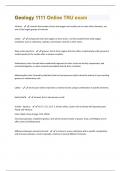Geology 1111 Online TRU exam
silicates - minerals that contain silicon and oxygen and usually one or more other elements, are
one of the largest groups of minerals
oxides - compounds that have oxygen as their anion, t ut they exclude those with oxygen
complexes such as carbonate, suphate, and silicate. have O2 as their anion,
Ways rocks may form - Igneous: forms from magma that has either cooled slowly under ground or
cooled quickly at the surface after a volcanic eruption
Sedimentary rocks: formed when weathered fragments fo other rocks are buried, compressed, and
cemented together, or when minerals precipitate directly from a solution
Metamorphic rocks: formed by alteration (due to heat pressure and/or chemical action) of a pre-existing
igneous or sedimentary rock
Lattice - 3d structure which represents a mineral and its unique combination of specific elements.
Halite (NaCl) - mineral, that is also known as salt.
Granite - Igneous - H: 6-7, S.G. 2.6-2.7, Streak: white, Luster: Dull to Grainy with Sporadic parts
Pearly and Vitreous
Color: Black, Grey, Orange, Pink, White
Very hard, granular, crystalline igneous rock which consists mainly of quartz, mica, and feldspar and is
often used as building stone
difference between mineral and rock - a mineral is a pure substance with a specific composition
and structure whereas a rock is typically a mixture of several different minerals.
,the mantle - made up of iron and magnesium silicate materials. Most of the mantle which
surrounds the outer core is solid rock, but is plastic enough to be able to flow slowly. Surrounding that
part of the mantle is a partially molten layer, the asthenosphere, and the outermost part of the mantle
which is rigid.
Asthenosphere -
Lithosphere -
tectonic plates -
the crust - Earth's outermost layer. mostly composed of granite on the continents and mostly of
basalt beneath the oceans. Is rigid. The crust and the outermost rigid part of the mantle together make
up the lithosphere which is divided into about 20 tectonic plates that move in different directions on
earth's surface
Geothermal gradient - the temperature increases in the earth with depth. approximately 30
Celsius a kilometer
convection - the primary driving force for the movement of tectonic plates. the transfer of heat
from the core to the mantle causing convection, as cold from the core goes down creating circular
heating/cooling patterns. Where convection currents in the antle are moving upward, new lithosphere
forms and the plates are pushed apart
age of earth - 4,570 million years old
Phanerozoic Eon - the last 542 million years in geological time
mineral - a naturally occurring combination of specific elements arranged in a particular repeating
three dimentional structure
Atomic number - the number of protons in an atom
, atomic mass - the number of protons plus neutrons in an atom
cation - a positively charged ion (when an atom during a reaction loses electrons)
anion - A negatively charged ion, when during transfer when an atom gains one or more electrons
in order to become a negatively charged ion
covelant bond - A bond when atoms share their outermost electrons in order to balance their
charge. does not form an ion
sulphides - Have an S-2 anion, can also have an SO4-2 anion
halides - Minerals that contain a halogen ion plus one or more other elements
Carbonates - Minerals that contain the elements carbon, oxygen, and one or more other metallic
elements, such as CO-3
phosphate - PO4 anion
Native minerals - single element minerals such as gold copper, sulphur and graphite
formation of minerals - elements needed to make it must be present in the appropriate
proportions, and the physical and chemical conditions must be favorable with enough time for the atoms
to become arranged accordingly. Can form either volcanically by the cooling of magma/lave, through
precipitation, metamorphism, weathering or organic formation
forms of diagnosing minerals - color, streak, lustre, hardness, crystal habit, cleavage and fracture,
and density
colour - some minerals have distinct colors, many do not. variation in colours due to proportions
of trace elements within the mineral




